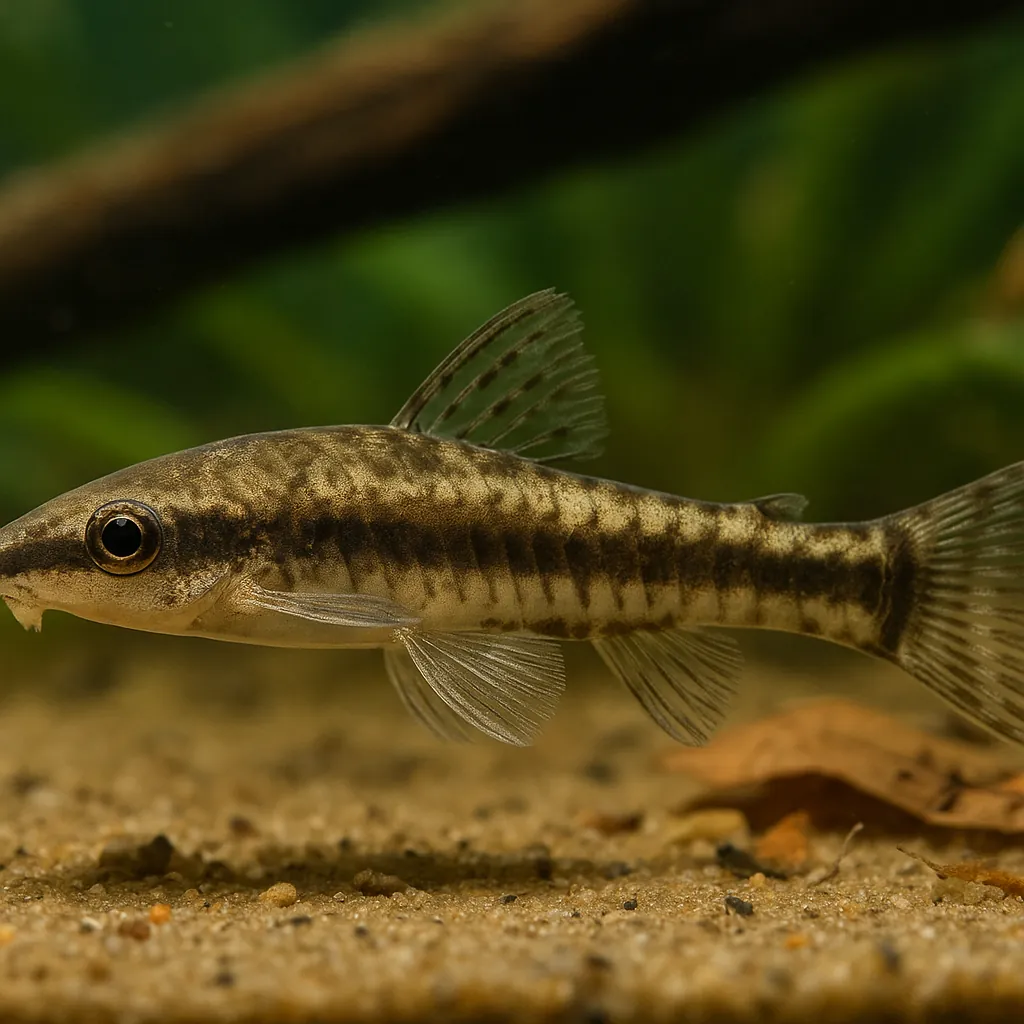
Dwarf Sucker (Otocinclus)
Introduction
The Otocinclus, also known as the Dwarf Sucker, is a small, peaceful freshwater fish cherished by aquarists for its exceptional algae-eating abilities and gentle nature. These diminutive catfish are ideal for community tanks, especially those with live plants, as they help maintain a clean environment by grazing on algae. Their manageable size and non-aggressive temperament make them suitable for both novice and experienced fishkeepers seeking an efficient and amiable tank inhabitant.
What makes the Otocinclus a popular choice among aquarists?
Its algae-eating prowess and peaceful demeanor make it a valuable addition to community aquariums, particularly those with live plants.
Is the Otocinclus suitable for beginners?
Yes, with proper care and a stable environment, they can thrive, making them appropriate for both novice and experienced fishkeepers.
Care and Environment
Providing optimal care for the Dwarf Otocinclus involves attention to tank size, water parameters, diet, and habitat setup to ensure their health and longevity.
What is the minimum tank size for a Otocinclus?
A minimum tank size of 10 gallons (approximately 38 liters) is recommended to accommodate a small group, as they are social fish that thrive in groups of at least six individuals.
What are the ideal water parameters for Otocinclus?
Maintain a temperature between 72°F and 78°F (22°C to 26°C), a pH range of 6.0 to 7.5, and water hardness between 2 to 15 dGH. Consistent water quality is crucial, as they are sensitive to fluctuations.
How should the tank be set up for Otocinclus?
Use a soft substrate like sand or fine gravel to protect their delicate undersides. Incorporate live plants, driftwood, and rocks to provide hiding spots and surfaces for algae growth, which they feed on. Ensure the tank is well-established with sufficient algae before introducing them.
What should be included in their diet?
While they primarily consume algae, supplement their diet with high-quality algae wafers, blanched vegetables such as zucchini, cucumber, and spinach, and occasional protein sources like brine shrimp or daphnia. Feed small amounts daily, removing uneaten food to maintain water quality.
Are there any specific challenges in keeping Otocinclus?
They are sensitive to changes in water parameters and require a stable, clean environment. Additionally, they should be introduced to mature tanks with established algae growth to meet their dietary needs.
Origin and Habitat
Native to South America, Dwarf Suckers are found in countries like Brazil, Peru, and Colombia. They inhabit well-oxygenated, slow to moderate-flowing rivers and streams with abundant vegetation and submerged structures. These environments provide ample surfaces for algae growth, their primary food source. The water in their natural habitat is typically soft and slightly acidic, with temperatures ranging from 70°F to 79°F (21°C to 26°C).
Where are Dwarf Suckers naturally found?
They are native to South American countries such as Brazil, Peru, and Colombia.
What type of environments do they inhabit?
They reside in well-oxygenated rivers and streams with slow to moderate flow, abundant vegetation, and submerged structures conducive to algae growth.
Temperament and Compatibility
Dwarf Suckers are peaceful, social fish that thrive in groups of at least six. They are non-aggressive and can coexist harmoniously with other small, peaceful species. Suitable tank mates include Neon Tetras, Ember Tetras, Harlequin Rasboras, Corydoras Catfish, Cherry Barbs, Guppies, Zebra Danios, and Endler's Guppies. Avoid housing them with large or aggressive fish, as they can be outcompeted for food or stressed by aggressive behavior.
Are Otocinclus suitable for community tanks?
Yes, their peaceful nature makes them excellent additions to community aquariums with other small, non-aggressive fish.
What are some ideal tank mates for Otocinclus?
Compatible species include Neon Tetras, Ember Tetras, Harlequin Rasboras, Corydoras Catfish, Cherry Barbs, Guppies, Zebra Danios, and Endler's Guppies.
Why is it important to keep Otocinclus in groups?
They are social fish that feel more secure and exhibit natural behaviors when kept in groups of at least six individuals.
Interesting Facts
Otocinclus possess unique traits that endear them to aquarists. They have specialized mouths adapted for scraping algae off surfaces, making them efficient tank cleaners. Despite their small size, they are known for their active and industrious nature, often seen clinging to glass, plants, and decorations as they graze on algae. Breeding them in captivity is challenging, and most available specimens are wild-caught. They have a lifespan of approximately 3 to 5 years when provided with proper care.
What makes Otocinclus effective algae eaters?
Their specialized suckermouths are adapted for scraping algae off various surfaces, contributing to a cleaner aquarium environment.
Is it common to breed Otocinclus in home aquariums?
Breeding them in captivity is difficult, and most specimens available in the trade are wild-caught.
Sources
All information in this article has been gathered from the following reputable sources:
Overview
Recommended Tank Size 19.8 Gallons (for groups of 6 or more) |
Minimum Group Size 6 |
Minimum Tank Volume 10 Gallons |
Maximum Adult Length 2 inches |
Average Adult Length 1.6 inches |
Shoaling (6+ required) Yes |
Preferred Water Type Freshwater, soft, slightly acidic to neutral |
Temperature Range (°C) 22–26 |
pH Range 6.0–7.5 |
Water Hardness (dGH) 2–15 |
Typical Lifespan (years) 3 years |